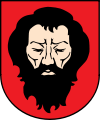 Alternate names: Trakai [Lith], Troki [Pol, Rus], Trok [Yid], Traken [Ger], Trakay, Troki Nowe, Troki Nove, Novyye Troki, Russian: Троки. Yiddish: טראָק. 54°38' N, 24°56' E, 16 miles WSW of Vilnius (Vilna). 1900 Jewish population: 1,112. Yizkor: Troki (Tel Aviv, [1954]).From the times of Vytautas the Great, Trakai was inhabited by Karaites from the Crimea. They observed Judaism, but were not considered Jews. The exact time Jews came to Trakai is unknown. 1897 census: 818 Jews and 424 Karaites. In Autumn 1941, the total population of the town of Trakai was 2,640 with 4,305 Jews in Trakai District (2.61 % of the total). Towns in Trakai district are Alytus, Aukstadvaris, Butrimonys, Darsuniskis, Daugai, Druskininkai, Jieznas, Merkine, Mikalavas, Miroslavas, Nemajunai, Nemunaitis, Onuskis, Paluknys, Pivasiuniai, Punia, Ratnycia, Semeliskes, Stakliskes, Trakai, Valkaninkai, Varena, Vievis, Zasliai, and Ziezmariai. Trakai District Research Group. [March 2009]
Alternate names: Trakai [Lith], Troki [Pol, Rus], Trok [Yid], Traken [Ger], Trakay, Troki Nowe, Troki Nove, Novyye Troki, Russian: Троки. Yiddish: טראָק. 54°38' N, 24°56' E, 16 miles WSW of Vilnius (Vilna). 1900 Jewish population: 1,112. Yizkor: Troki (Tel Aviv, [1954]).From the times of Vytautas the Great, Trakai was inhabited by Karaites from the Crimea. They observed Judaism, but were not considered Jews. The exact time Jews came to Trakai is unknown. 1897 census: 818 Jews and 424 Karaites. In Autumn 1941, the total population of the town of Trakai was 2,640 with 4,305 Jews in Trakai District (2.61 % of the total). Towns in Trakai district are Alytus, Aukstadvaris, Butrimonys, Darsuniskis, Daugai, Druskininkai, Jieznas, Merkine, Mikalavas, Miroslavas, Nemajunai, Nemunaitis, Onuskis, Paluknys, Pivasiuniai, Punia, Ratnycia, Semeliskes, Stakliskes, Trakai, Valkaninkai, Varena, Vievis, Zasliai, and Ziezmariai. Trakai District Research Group. [March 2009]
CEMETERY:
BOOK: Les langues des inscriptions israelites funeraires au cimetiere de Troki (The languages of the graves inscriptions in Troki [Trakai] cemetery), by L. Hersch. Rome, 193?. 38 pages, French. S37B1841. Notes: 21 tombstones, 1852-1910, Caraites, Hebrew inscriptions (some with Russian or Polish translation added). Source: Tagger, Mathilde. Printed Books on Jewish Cemeteries in the Jewish National and University Library in Jerusalem: an Annotated Bibliography. Jerusalem: The Israel Genealogical Society, 1997.
MASS GRAVES: A small Red Army unit (80 soldiers and one political instructor) located in Trakai blew up military depots and retreated eastwards. Local Lithuanian Nazi collaboraters organized an armed militia and prevented blowing ammunition depots. Lithuania rebels wounded two and captured eighteen Red Army soldiers during an exchange on June 23. The German Army occupied the town on June 24. Public, criminal and security police were organized in Trakai town and district. In July, former Red Army Lithuanian soldiers organized a battalion of about 120 men that guarded military depots and convoyed Russian war prisoners to Onuškis, Semeliškes and Šventežeris. In August 1941, the Jews first suffered legal discrimination. On August 1, the governor of Trakai District instructed town and rural districts police chiefs to treat people of all nationalities equally except for Jews. Weekly food rations for the Jews were less than half those of non-Jews. The Jews were forbidden to have radios. In July, Governor of Trakai District established a ghetto and a Jewish council with a manager and deputy. On August 16, Vilnius, Švenčionys, Trakai and Alytus district officials moved half the Jews into the ghettos including persons with one Jewish parent, but the Jews of Trakai continued to live in their houses and apartments. In early September, the police transported about 400 Jews by boats to a ghetto set up in summerhouses. Jews from Aukštadvaris, Onuškis and Lentvaris were taken there a bit later. Policemen guarded Trakai Ghetto until its liquidation a week or so later when the Governor of Trakai District ordered the murders. K. Čaplikas and his subordinates refused to carry out this order. A week later, 20-30 policemen from Vilnius special force came to Trakai by bus with an SS non-commissioned officer to shoot the Jews in Varnikai forest near the lake, about 3 km from Trakai. Local policemen and white-bands guarded the massacre site. The massacre began in the morning and ended in the afternoon as 1,446 Jews (366 men, 483 women and 597 children) were taken in groups to the pit and shot. After shooting, the special force had a drunken vodka feast in the local Trakai canteen. The killers left for Vilnius - singing. Worried about the sanitary status and protection of mass graves, te Trakai District governor instructed the burgomaster of Trakai and chiefs of Žiežmariai, Semeliškes and Eišiškes Rural Districts to fence the mass grave area with 120 cm high fencing to keep people and animals out and to distribute lime chloride on the mass graves. On July 8, 1942, a doctor in Trakai District informed the Commander of Vilnius District that the mass graves of Trakai District in Trakai, Semeliškes and Žiežmariai Rural Districts had been strewn with bleach and refilled with soil in 1941 and that in Spring 1942, the mass graves were disentombed, strewn with bleach, and fenced. [March 2009]
Forest of Varnikai, about 3 km from Trakai, on the bank of the lake; 176; pic. # 311-312 US Commission for the Preservation of America's Heritage Abroad
